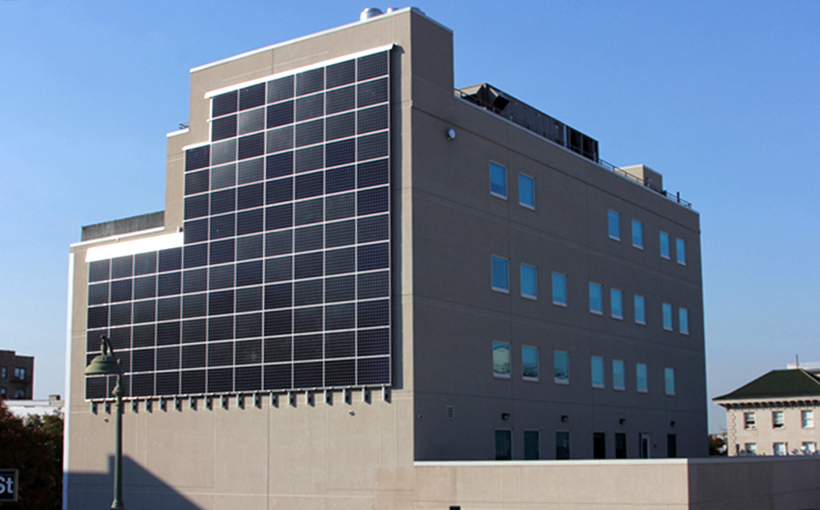
President Trump’s plan to erect a wall at the border between the U.S. and Mexico has encountered some financial issues. That led to different suggestions, including the possibility of installation of solar panels on the fence so that it could pay for itself.
Some engineers have noted the problems with this suggestion. They note that the border latitude is about 28 degrees north. That means that in summer the sun would be nearly overhead. If the panels were mounted on the wall they would get almost no sun.
Solar experts say mounting panels (which would have to be on the Southern face of the wall) at 90 degrees would reduce their output 50–70%. And they would be prone to vandalism or more likely stolen.
They also advise that in such a remote area, they would need to be paired with batteries to store the energy they produce, which would go towards powering up security cameras and sensors, but nothing more.
Politics aside, it is possible for solar panels to be wall-mounted if there’s no roof space available. Some companies have done it to varying degrees of success.
Some solar installers have adapted existing mounting and racking or develop their own to do these type of commercial projects.
Quixotic Systems in New York City is one of these outfits trying their hand at facade solar installations.
“Roof space in NYC is often limited. A solar system can then offset only a small portion of a building’s electrical usage. One solution is to install solar panels on a south facing wall of the building. The picture shows above shows one such innovative system, the first of its kind in the Bronx,” they note on their webpage.
A total of 104 solar panels went on the side of the Simpson Pavilion in the South Brown. The energy-efficient building already had a green roof and there was no space for adding photovoltaic (PV) modules. So Quixotic used one side of the structure for this purpose.
Arctic Solar Ventures in Alaska is also trying this approach. They did so to boost energy production in the winter, when the sun doesn’t rise much above the horizon. The vertical placement also eliminates the accumulation of snow on the panels, which could be quite heavy in the northwestern state.
Just like the engineers above who dismissed the idea of putting solar panels on Trump’s border fence, there is a drop if efficiency when putting the solar panels flat, rather upturned on a roof. But there will still be energy production. Some estimates are of 70%.
GoSmartBricks notes that vertical solar panels are not completely out of the norm.
It notes that placing solar panels horizontal “it’s easier and cheaper to install and can stand without the need for scaffolding. Secondly, horizontal setups are extensively tested and streamlined for both roof- and ground-mounted systems, hence the industry is quite well set up for this type of installation. Basically, installing solar panels on the side of a building structure is hardly the first choice for any developer, but few customers prefer vertical wall-mounted arrangement."
And it points to several advantages for vertical placing. One of them is utilizing unused spaced.
“The sides of buildings are archetypally large (except maybe for windows). Hence these sides are perfect for straight rows of solar panels all along the face. Also, the taller the building, the more is the space to install vertical panels which can also mean more energy savings,” it says.
There’s also the issue of self-cleaning, meaning rain will wash out dust and other debris a lot easier when they’re attached to a wall, instead of nearly flat on the roof.
And “for those who live in snow-heavy areas, installing vertical solar panels can help with production. When snow completely covers the panels for weeks during winters, sun rays might not reach the panels. Since snow restricts solar energy from reaching the panels the sunny days during those cold months go waste, vertical solar panels work best in such areas,” it adds.
But these type of installations do have drawbacks, it states. One being lower energy production, another is installation challenges. There will certainly be the need to adapt or create special mounting hardware and there are also higher safety considerations for the workers doing the job.
All of that translates into higher costs for the projects, as well as more difficulties with repairs and maintenance.
And let’s not discount building codes. If this is an option for a commercial solar project, you will have to clear it with the city first, as they might have some regulations regarding this.
HahaSmart Blog - More Solar Tips and Guide
HahaSmart News - Stay Informe
Your Solar Incentives - See Credits and Incentives in Your Area
Check Your Home's Solar Price - See How Much You Sav
Register Now - Unlock The Lowest Solar Prices in Your Area


Input your address to see if it is solar friendly and how much you can save with solar.
Great. Your address is perfect for solar. Solar incentive is still available. Select monthly utility cost and calculate the size of solar system you will need now.
| kw System size | years Payback period | Lifetime savings |
No money down, 100% finance is available.
|
|
Sign up to understand more about solar panel costs, see quote right away |
Comments